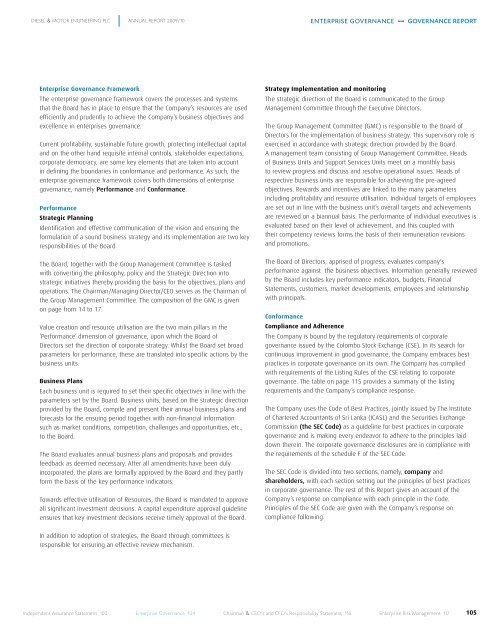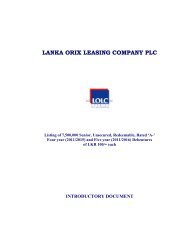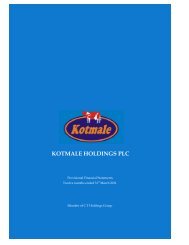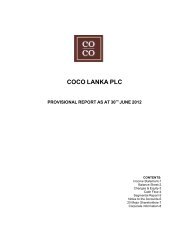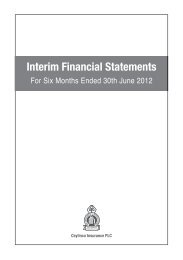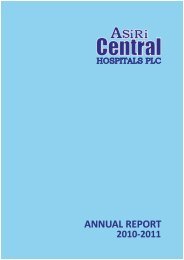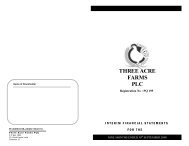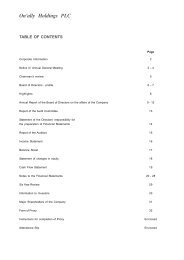directors - Colombo Stock Exchange
directors - Colombo Stock Exchange
directors - Colombo Stock Exchange
You also want an ePaper? Increase the reach of your titles
YUMPU automatically turns print PDFs into web optimized ePapers that Google loves.
DIESEL & MOTOR ENGINEERING PLC ANNUAL REPORT 2009/10<br />
Enterprise Governance Framework<br />
The enterprise governance framework covers the processes and systems<br />
that the Board has in place to ensure that the Company’s resources are used<br />
efficiently and prudently to achieve the Company’s business objectives and<br />
excellence in enterprises governance.<br />
Current profitability, sustainable future growth, protecting intellectual capital<br />
and on the other hand requisite internal controls, stakeholder expectations,<br />
corporate democracy, are some key elements that are taken into account<br />
in defining the boundaries in conformance and performance. As such, the<br />
enterprise governance framework covers both dimensions of enterprise<br />
governance, namely Performance and Conformance.<br />
Performance<br />
Strategic Planning<br />
Identification and effective communication of the vision and ensuring the<br />
formulation of a sound business strategy and its implementation are two key<br />
responsibilities of the Board.<br />
The Board, together with the Group Management Committee is tasked<br />
with converting the philosophy, policy and the Strategic Direction into<br />
strategic initiatives thereby providing the basis for the objectives, plans and<br />
operations. The Chairman/Managing Director/CEO serves as the Chairman of<br />
the Group Management Committee. The composition of the GMC is given<br />
on page from 14 to 17.<br />
Value creation and resource utilisation are the two main pillars in the<br />
‘Performance’ dimension of governance, upon which the Board of<br />
Directors set the direction of corporate strategy. Whilst the Board set broad<br />
parameters for performance, these are translated into specific actions by the<br />
business units.<br />
Business Plans<br />
Each business unit is required to set their specific objectives in line with the<br />
parameters set by the Board. Business units, based on the strategic direction<br />
provided by the Board, compile and present their annual business plans and<br />
forecasts for the ensuing period together with non-financial information<br />
such as market conditions, competition, challenges and opportunities, etc.,<br />
to the Board.<br />
The Board evaluates annual business plans and proposals and provides<br />
feedback as deemed necessary. After all amendments have been duly<br />
incorporated, the plans are formally approved by the Board and they partly<br />
form the basis of the key performance indicators.<br />
Towards effective utilisation of Resources, the Board is mandated to approve<br />
all significant investment decisions. A capital expenditure approval guideline<br />
ensures that key investment decisions receive timely approval of the Board.<br />
In addition to adoption of strategies, the Board through committees is<br />
responsible for ensuring an effective review mechanism.<br />
e n t e r p r i s e g ov e r n a n C e goVernance report<br />
Strategy Implementation and monitoring<br />
The strategic direction of the Board is communicated to the Group<br />
Management Committee through the Executive Directors.<br />
The Group Management Committee (GMC) is responsible to the Board of<br />
Directors for the implementation of business strategy. This supervisory role is<br />
exercised in accordance with strategic direction provided by the Board.<br />
A management team consisting of Group Management Committee, Heads<br />
of Business Units and Support Services Units meet on a monthly basis<br />
to review progress and discuss and resolve operational issues. Heads of<br />
respective business units are responsible for achieving the pre-agreed<br />
objectives. Rewards and incentives are linked to the many parameters<br />
including profitability and resource utilisation. Individual targets of employees<br />
are set out in line with the business unit’s overall targets and achievements<br />
are reviewed on a biannual basis. The performance of individual executives is<br />
evaluated based on their level of achievement, and this coupled with<br />
their competency reviews forms the basis of their remuneration revisions<br />
and promotions.<br />
The Board of Directors, apprised of progress, evaluates company's<br />
performance against the business objectives. Information generally reviewed<br />
by the Board includes key performance indicators, budgets, Financial<br />
Statements, customers, market developments, employees and relationship<br />
with principals.<br />
Conformance<br />
Compliance and Adherence<br />
The Company is bound by the regulatory requirements of corporate<br />
governance issued by the <strong>Colombo</strong> <strong>Stock</strong> <strong>Exchange</strong> (CSE). In its search for<br />
continuous improvement in good governance, the Company embraces best<br />
practices in corporate governance on its own. The Company has complied<br />
with requirements of the Listing Rules of the CSE relating to corporate<br />
governance. The table on page 115 provides a summary of the listing<br />
requirements and the Company’s compliance response.<br />
The Company uses the Code of Best Practices, jointly issued by The Institute<br />
of Chartered Accountants of Sri Lanka (ICASL) and the Securities <strong>Exchange</strong><br />
Commission (the SEC Code) as a guideline for best practices in corporate<br />
governance and is making every endeavor to adhere to the principles laid<br />
down therein. The corporate governance disclosures are in compliance with<br />
the requirements of the schedule F of the SEC Code.<br />
The SEC Code is divided into two sections, namely, company and<br />
shareholders, with each section setting out the principles of best practices<br />
in corporate governance. The rest of this Report gives an account of the<br />
Company’s response on compliance with each principle in the Code.<br />
Principles of the SEC Code are given with the Company’s response on<br />
compliance following.<br />
Independent Assurance Statement 100 Enterprise Governance 104 Chairman & CEO’s and CFO’s Responsibility Statement 116 Enterprise Risk Management 117<br />
105


